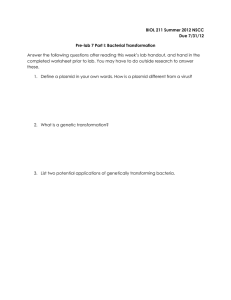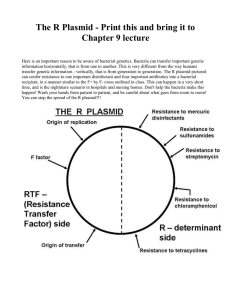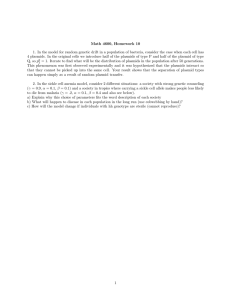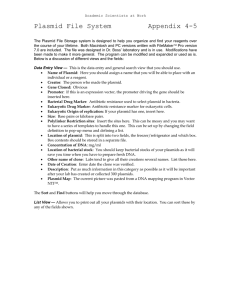Plasmid segregation: spatial awareness at the molecular level
advertisement
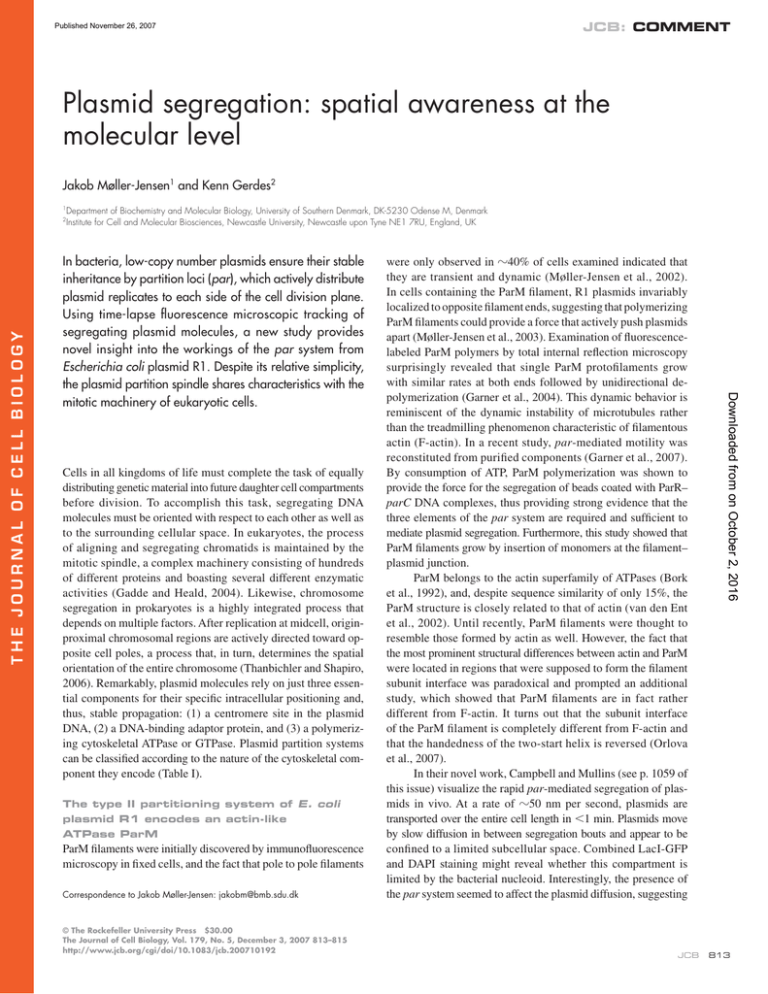
JCB: COMMENT Published November 26, 2007 Plasmid segregation: spatial awareness at the molecular level Jakob Møller-Jensen1 and Kenn Gerdes2 1 Department of Biochemistry and Molecular Biology, University of Southern Denmark, DK-5230 Odense M, Denmark Institute for Cell and Molecular Biosciences, Newcastle University, Newcastle upon Tyne NE1 7RU, England, UK In bacteria, low-copy number plasmids ensure their stable inheritance by partition loci (par), which actively distribute plasmid replicates to each side of the cell division plane. Using time-lapse fluorescence microscopic tracking of segregating plasmid molecules, a new study provides novel insight into the workings of the par system from Escherichia coli plasmid R1. Despite its relative simplicity, the plasmid partition spindle shares characteristics with the mitotic machinery of eukaryotic cells. Cells in all kingdoms of life must complete the task of equally distributing genetic material into future daughter cell compartments before division. To accomplish this task, segregating DNA molecules must be oriented with respect to each other as well as to the surrounding cellular space. In eukaryotes, the process of aligning and segregating chromatids is maintained by the mitotic spindle, a complex machinery consisting of hundreds of different proteins and boasting several different enzymatic activities (Gadde and Heald, 2004). Likewise, chromosome segregation in prokaryotes is a highly integrated process that depends on multiple factors. After replication at midcell, originproximal chromosomal regions are actively directed toward opposite cell poles, a process that, in turn, determines the spatial orientation of the entire chromosome (Thanbichler and Shapiro, 2006). Remarkably, plasmid molecules rely on just three essential components for their specific intracellular positioning and, thus, stable propagation: (1) a centromere site in the plasmid DNA, (2) a DNA-binding adaptor protein, and (3) a polymerizing cytoskeletal ATPase or GTPase. Plasmid partition systems can be classified according to the nature of the cytoskeletal component they encode (Table I). The type II partitioning system of E. coli plasmid R1 encodes an actin-like ATPase ParM ParM filaments were initially discovered by immunofluorescence microscopy in fixed cells, and the fact that pole to pole filaments Correspondence to Jakob Møller-Jensen: jakobm@bmb.sdu.dk © The Rockefeller University Press $30.00 The Journal of Cell Biology, Vol. 179, No. 5, December 3, 2007 813–815 http://www.jcb.org/cgi/doi/10.1083/jcb.200710192 were only observed in 40% of cells examined indicated that they are transient and dynamic (Møller-Jensen et al., 2002). In cells containing the ParM filament, R1 plasmids invariably localized to opposite filament ends, suggesting that polymerizing ParM filaments could provide a force that actively push plasmids apart (Møller-Jensen et al., 2003). Examination of fluorescencelabeled ParM polymers by total internal reflection microscopy surprisingly revealed that single ParM protofilaments grow with similar rates at both ends followed by unidirectional depolymerization (Garner et al., 2004). This dynamic behavior is reminiscent of the dynamic instability of microtubules rather than the treadmilling phenomenon characteristic of filamentous actin (F-actin). In a recent study, par-mediated motility was reconstituted from purified components (Garner et al., 2007). By consumption of ATP, ParM polymerization was shown to provide the force for the segregation of beads coated with ParR– parC DNA complexes, thus providing strong evidence that the three elements of the par system are required and sufficient to mediate plasmid segregation. Furthermore, this study showed that ParM filaments grow by insertion of monomers at the filament– plasmid junction. ParM belongs to the actin superfamily of ATPases (Bork et al., 1992), and, despite sequence similarity of only 15%, the ParM structure is closely related to that of actin (van den Ent et al., 2002). Until recently, ParM filaments were thought to resemble those formed by actin as well. However, the fact that the most prominent structural differences between actin and ParM were located in regions that were supposed to form the filament subunit interface was paradoxical and prompted an additional study, which showed that ParM filaments are in fact rather different from F-actin. It turns out that the subunit interface of the ParM filament is completely different from F-actin and that the handedness of the two-start helix is reversed (Orlova et al., 2007). In their novel work, Campbell and Mullins (see p. 1059 of this issue) visualize the rapid par-mediated segregation of plasmids in vivo. At a rate of 50 nm per second, plasmids are transported over the entire cell length in <1 min. Plasmids move by slow diffusion in between segregation bouts and appear to be confined to a limited subcellular space. Combined LacI-GFP and DAPI staining might reveal whether this compartment is limited by the bacterial nucleoid. Interestingly, the presence of the par system seemed to affect the plasmid diffusion, suggesting JCB Downloaded from on October 2, 2016 THE JOURNAL OF CELL BIOLOGY 2 813 Published November 26, 2007 Table I. Bacterial plasmid partition systems Classification Type I Type II Type III Cytoskeletal element Dynamic characteristic DNA-binding anchor protein Walker-box ATPase, ParA Actin-like ATPase, ParM Tubulin-like GTPase, TubZ Oscillation Dynamic instability Treadmilling ParB ParR TubR Figure 1. Cartoon showing how ParR–parC DNA complexes interact with opposite ends of a growing ParM filament. The ParR N-terminal ribbon-helix-helix domain binds specifically to parC DNA (red), and the ParR C terminus interacts with ParM-ATP (blue) at or near the filament tips. ATP hydrolysis is proposed to induce a structural rearrangement in ParM that leads to the dislodging of ParR, which, in turn, can reassociate further outwards on the filament that consists of ParM-ATP. The figure was adapted from Møller-Jensen et al. (2007). 814 JCB • VOLUME 179 • NUMBER 5 • 2007 parC sites (Jensen et al., 1998). Perhaps the par spindle acts to separate paired, newly replicated plasmids as well as plasmid pairs that come into proximity by diffusion. With an R1 plasmid copy number of four to eight during normal growth conditions, the latter situation may occur quite often. The fact that single cells containing two pole to pole spindles can be observed occasionally in fixed cell preparations is consistent with this (unpublished data). An important remaining question regarding the par mechanism relates to the interaction between ParM filament ends and the ParR–parC complex. Like actin, ParM assembles head to tail into a polarized filament with distinguishable plus and minus ends (van den Ent et al., 2002; Orlova et al., 2007). How do plasmid molecules manage to interact with opposite filament ends at the same time? A clue to this question came with the crystal structure of the ParR protein (Møller-Jensen et al., 2007). ParR dimerizes to form a ribbon-helix-helix DNA-binding structure that further assembles into a helical (or ring shaped) array with DNA-binding domains presented on the exterior. Consistently, electron microscopic analysis of ParR–parC complexes showed parC-DNA wrapped around the ParR protein scaffold. Downloaded from on October 2, 2016 that force is also applied to plasmids that are not in the process of segregation. Campbell and Mullins (2007) went on to label both plasmid DNA and ParM in the same cells and confirmed that plasmids are always located at opposite ends of a growing ParM spindle. In addition, short filaments appeared to emanate from single plasmid foci, which is consistent with the observed effect on the plasmid diffusion rate. Campbell and Mullins (2007) present a search and capture model that explains how the par spindle might work. According to the model, ParM filaments form continuously throughout the cytoplasm but rapidly decay in the absence of stabilizing interactions with plasmid molecules. Filaments stabilized at one end will search the cytoplasm and, upon capture of a second plasmid, extend into a pole to pole spindle. This is similar to the way in which microtubules extend from the eukaryotic spindle pole body in the search for chromosomes during mitotic prometaphase. Although bipolar stabilization of ParM filaments is favored when two plasmid copies are in close proximity, plasmid pairing itself is not required. Thus, this model challenges a previous study showing that site-specific plasmid pairing takes place through interactions between ParR proteins bound to Published November 26, 2007 References Bork, P., C. Sander, and A. Valencia. 1992. An ATPase domain common to prokaryotic cell cycle proteins, sugar kinases, actin, and hsp70 heat shock proteins. Proc. Natl. Acad. Sci. USA. 89:7290–7294. Campbell, C.S., and R.D. Mullins. 2007. In vivo visualization of type II plasmid segregation: bacterial actin filaments pushing plasmids. J. Cell Biol. 179:1059–1066. Ebersbach, G., and K. Gerdes. 2005. Plasmid segregation mechanisms. Annu. Rev. Genet. 39:453–479. Ebersbach, G., S. Ringgaard, J. Møller-Jensen, Q. Wang, D.J. Sherratt, and K. Gerdes. 2006. Regular cellular distribution of plasmids by oscillating and filament-forming ParA ATPase of plasmid pB171. Mol. Microbiol. 61:1428–1442. Gadde, S., and R. Heald. 2004. Mechanisms and molecules of the mitotic spindle. Curr. Biol. 14:R797–R805. Garner, E.C., C.S. Campbell, and R.D. Mullins. 2004. Dynamic instability in a DNA-segregating prokaryotic actin homolog. Science. 306:1021–1025. Garner, E.C., C.S. Campbell, D.B. Weibel, and R.D. Mullins. 2007. Reconstitution of DNA segregation driven by assembly of a prokaryotic actin homolog. Science. 315:1270–1274. Gerdes, K., J. Møller-Jensen, and J.R. Bugge. 2000. Plasmid and chromosome partitioning: surprises from phylogeny. Mol. Microbiol. 37:455–466. Jensen, R.B., R. Lurz, and K. Gerdes. 1998. Mechanism of DNA segregation in prokaryotes: replicon pairing by parC of plasmid R1. Proc. Natl. Acad. Sci. USA. 95:8550–8555. Larsen, R.A., C. Cusumano, A. Fujioka, G. Lim-Fong, P. Patterson, and J. Pogliano. 2007. Treadmilling of a prokaryotic tubulin-like protein, TubZ, required for plasmid stability in Bacillus thuringiensis. Genes Dev. 21:1340–1352. Møller-Jensen, J., R.B. Jensen, J. Lowe, and K. Gerdes. 2002. Prokaryotic DNA segregation by an actin-like filament. EMBO J. 21:3119–3127. Møller-Jensen, J., J. Borch, M. Dam, R.B. Jensen, P. Roepstorff, and K. Gerdes. 2003. Bacterial mitosis: ParM of plasmid R1 moves plasmid DNA by an actin-like insertional polymerization mechanism. Mol. Cell. 12:1477–1487. Møller-Jensen, J., S. Ringgaard, C.P. Mercogliano, K. Gerdes, and J. Lowe. 2007. Structural analysis of the ParR/parC plasmid partition complex. EMBO J. 26:4413–4422. Orlova, A., E.C. Garner, V.E. Galkin, J. Heuser, R.D. Mullins, and E.H. Egelman. 2007. The structure of bacterial ParM filaments. Nat. Struct. Mol. Biol. 14:921–926. Thanbichler, M., and L. Shapiro. 2006. Chromosome organization and segregation in bacteria. J. Struct. Biol. 156:292–303. van den Ent, F., J. Møller-Jensen, L.A. Amos, K. Gerdes, and J. Lowe. 2002. F-actin-like filaments formed by plasmid segregation protein ParM. EMBO J. 21:6935–6943. Downloaded from on October 2, 2016 These findings suggest that the ParR–parC complex can encircle ParM filaments and slide along the polymer. As the ParR–parC complex has twofold symmetry, this interaction may occur in inverse orientations at opposite ends of the ParM filament, thus explaining the topological problem of how ParR–parC can interact with both ends of a polar ParM filament. This model is shown schematically in Fig. 1. Data presented by Campbell and Mullins (2007) indicate that ParM spindles may consist of more than one protofilament. Based on the ParR crystal structure, it is not immediately clear how the ParR–parC complex can interact with more than one ParM filament at one time, and, thus, the question of how a plasmid can search for a segregation partner and become captured at the same time remains open. Structural analysis of the trimeric ParMRC complex is required to resolve this issue. The new data presented by Campbell and Mullins (2007) demonstrate convincingly how type II par-mediated plasmid segregation is a totally autonomous undertaking: it can initiate from anywhere in the cell cytoplasm and in any direction relative to the cylindrical host cell compartment. It has no requirement for host cell factors (apart from ATP) and can take place repeatedly and at any stage in the host cell cycle (Campbell and Mullins, 2007). The more widespread type I family of bacterial DNA segregation systems uses ATPases of the Walker type (termed ParA). ParA proteins form filamentous structures that move through the cell in an oscillatory pattern. Like ParR of plasmid R1, the DNA-binding adaptor proteins (ParB) of these systems serve as tethers between ParA and plasmid centromere sites (parS; Ebersbach and Gerdes, 2005). Although the mechanism is less clear, this system is equally capable of stabilizing plasmid molecules and, in fact, manages to distribute multiple plasmids with maximal intermolecular distance along the cell length (Ebersbach et al., 2006). Recently, an ancient tubulin homologue, TubZ, was shown to be responsible for plasmid maintenance in Bacillus thuringiencis (Larsen et al., 2007). TubZ forms flexible and dynamic filaments, which quite unexpectedly display treadmilling behavior rather than dynamic instability. Analogous to other partition systems, the tubZ gene is cotranscribed with a smaller gene, tubR, which encodes a protein with DNA-binding capability (Larsen et al., 2007). It remains to be determined exactly how the force generated by moving TubZ filaments is translated into plasmid stabilization. In keeping with previous nomenclature (Gerdes et al., 2000), we propose that partitioning systems containing TubZ GTPases are classified as type III. Although there is no homology between the force-generating proteins or the DNA-binding adaptor proteins of the three types of partitioning systems, it appears that they share a similar modus operandum, which is to couple plasmids via specific adaptors to dynamic cytoskeletal filaments for intracellular transport. As more plasmids become sequenced and characterized, the plasmid segregation repertoire is likely to expand, and sophisticated fluorescence microscopy like that presented by Campbell and Mullins (2007) will undoubtedly lead to future excitement in the field. Submitted: 29 October 2007 Accepted: 2 November 2007 PLASMID SEGREGATION IN BACTERIA • MØLLER-JENSEN AND GERDES 815

